The Russian stove with a stove bench and a stove is a classic construction, the history of which goes back centuries. This device is practical and versatile. It is at the same time a means for heating a country house, cooking, cozy and comfortable rest.
Furnace history
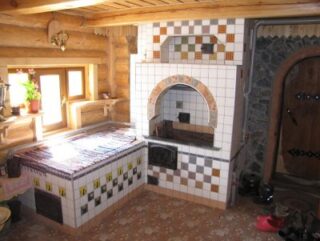
The traditional home life of a peasant in any country in the world was literally built around a stove. Given the level of technology development during the Middle Ages, this structure was the only available means for heating a building, cooking food, and drying things. And given the cramped conditions, it was also a place for several people to sleep. Over the centuries-old history of operation, many designs of the hearth have been developed, but they all have a common fundamental structure - a large vaulted combustion chamber, thick walls, a brick chimney.
The Swedish stove with a stove bench and a hob fits perfectly into the modern interior of a country house.
Main types
Over a long period of operation, home stoves have been repeatedly modernized in relation to the situation and architectural traditions of a particular area. Their description is found in abundance in literary works.
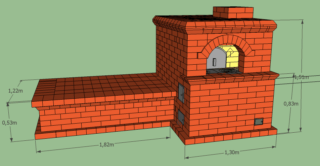
By design, the devices are divided into the following types:
- Russian. It is a large structure, inside of which there are chimney channels through which the combustion products go into the chimney, heating the walls and the lounger. According to the method of removing gases, they are hollow inside and with a channel system. In the first case, only the top is heated. In the second, the generated heat is concentrated at the bottom, providing a comfortable microclimate in the room.
- Swede. This technology appeared in Russia at the beginning of the 18th century. The structure is compact, presentable, functional and highly efficient. The structure has a vertical orientation with a support area of up to one square meter. A sophisticated chimney system provides heat throughout the entire height of the hearth. Thanks to this, it is possible to arrange the hob, fireplace, oven and dryer for herbs on different levels.
- Cast iron. The construction is simple, reliable and efficient. It is a metal boiler of normal or long burning, lined with fireclay bricks and tiles. It does not require special skill when installing, but you will have to pay a lot for the metal.
There are freestanding and combined ovens, large, medium and small, simple and complex geometry. The walls of the structure are left as they are, whitewashed, plastered, and decorated with decorative tiles.
Benefits of a stove stove
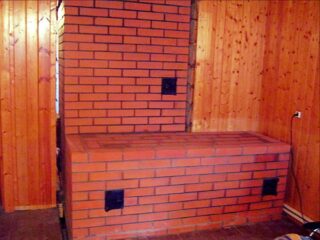
Users note the following advantages of a home stove with a lounger:
- multifunctionality;
- high heat transfer;
- environmental and fire safety;
- allocation of additional sleeping places or storage room;
- heat capacity, as a result of efficiency;
- the calming and healing effect of being on the bed;
- ease of use;
- applicability of any type of solid fuel;
- durability;
- presentability;
- the ability to build and carry out repairs with your own hands.
The disadvantages include the dependence of the owners on a constant supply of fuel, the need to build a separate foundation and large financial investments even for the simplest project.
Device and principle of operation
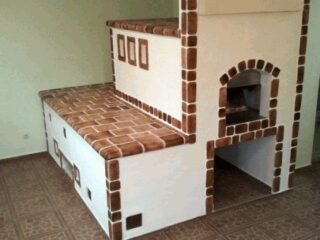
The option with a stove bench assumes the allocation of additional 2-4 square meters of usable area, but such a decision cannot be called a cost, since there are much more positive aspects in it.
Owners get at their disposal a design with the following options:
- heating;
- Cooking;
- drying shoes and clothes;
- sleeping place;
- treatment of many diseases;
- relaxation zone;
- an original element of the interior.
The stove is placed on a powerful separate foundation. The brick case contains the following elements:
- main firebox;
- crucible;
- walls;
- sunbed;
- chimney system with supports;
- ash pan;
- hob;
- chimney;
- storage space for kitchen utensils;
- niche for firewood.
The principle of operation of a modern oven with beds is as follows:
- heating, together with ensuring a high temperature of the furnace, also heats up the very bottom of the furnace;
- firewood is burned in the firebox on the grate;
- adjacent to the bottom of the crucible under, and from above - the arch;
- flue gases through the underside enter the furnace, heating it up, and then pass along the perimeter to the lower and upper heating chambers, leaving the furnace through the pipe.
The average heat output is up to 4.0 kW per day.
How to build a Russian stove yourself
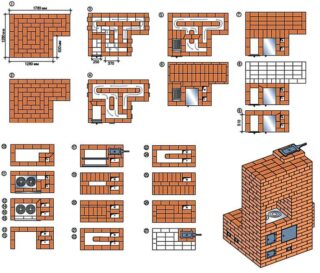
The first step is to determine the location, size and configuration of the focus. The order of the body and the chimney is determined. After that, a detailed drawing, an estimate is made, materials are purchased and tools are prepared.
Step-by-step instruction:
- Measurements and markings. The floorboards are opened if necessary.
- Arrangement of the foundation. A reinforced concrete slab is made, buried below the freezing point of the soil. It takes 21-28 days to wait for the concrete to harden.
- Laying bricks on a waterproofing layer. The first 5 rows go to the flood, then an arch is formed (6-10). Along the way, channels are formed through which hot air will heat the lower and upper parts of the furnace. Starting from the 11th row, the throat, the bend, the mouth, the crucible, the six are laid out. After that, various niches are made and a bed is made above the 32nd level. The bricks are placed on props, and the masonry is covered with a board shield on top.
- Chimney outlet. A square pipe is made with a side of 2 bricks. Dampers and dampers are inserted at the same time. A protective umbrella with a grid for sparks is attached to the top.
The finished product is dried for at least a week, and paper with a splinter is constantly thrown into the firebox and crucible. After carrying out a test furnace, you can start finishing work.








